《翻译理论与实践》课程教学资源(教案讲义)英汉翻译教案(内蒙古科技大学:赵蕾)
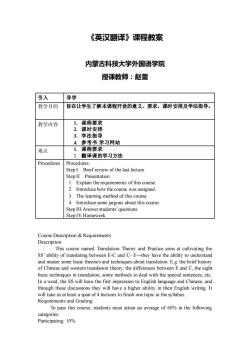
《英汉翻译》课程教案 内蒙古科技大学外国语学院 授课教师:赵蕾 引入 导学 教学目的 旨在让学生了解本课程开设的意义、要求,课时安排及学法指导。 教学内容 1.课程要求 2.课时安排 3.学法指导 4,参考书学习网站 难点 1. 2. 翻译课的学习方法 Procedures StepI Brief review of the last lecture StepII Presentation Explain the requirements of this course 2.Introduce how the course was assigned. 3.The learning method of this course me jargons about this course Answer stu StepIV Homework Course Description&Requirements This course named Translation Theory and Practice aims at cultivating the SS'ability of translating between E-C and C-E-they have the ability to understand and master some basic theories and techniques about translation.E.g.the brief history of Chinese and western translation theory,the differences between E and C,the eight basictec ques in translation. some methods todeal with the special sente ces,et Chinese,and through these discussions they will have a higher ability in their English writing.It will take us at least a span of 4 lectures to finish one topic in the syllabus. Requirements and Grading. To pass this course students must attain an average of 60%in the following categories Participating:10%
《英汉翻译》课程教案 内蒙古科技大学外国语学院 授课教师:赵蕾 Course Description & Requirements Description: This course named Translation Theory and Practice aims at cultivating the SS’ ability of translating between E-C and C- E—they have the ability to understand and master some basic theories and techniques about translation. E.g. the brief history of Chinese and western translation theory, the differences between E and C, the eight basic techniques in translation, some methods to deal with the special sentences, etc. In a word, the SS will have the first impression to English language and Chinese, and through these discussions they will have a higher ability in their English writing. It will take us at least a span of 4 lectures to finish one topic in the syllabus. Requirements and Grading: To pass this course, students must attain an average of 60% in the following categories: Participating: 10% 引入 导学 教学目的 旨在让学生了解本课程开设的意义、要求,课时安排及学法指导。 教学内容 1. 课程要求 2. 课时安排 3. 学法指导 4. 参考书 学习网站 难点 1. 课程要求 2. 翻译课的学习方法 Procedures Procedures: Step I Brief review of the last lecture Step II Presentation 1. Explain the requirements of this course. 2. Introduce how the course was assigned. 3. The learning method of this course. 4. Introduce some jargons about this course. Step III Answer students’ questions Step IV Homework
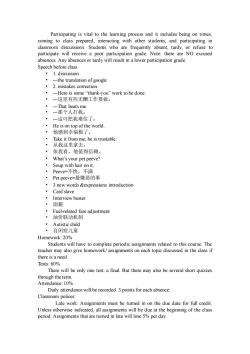
Participating is vita to cess and it includes being on time coming to class prepared, interacting with other students, and participating in classroom discussions.Students who are frequently absent,tardy,or refuse to participate will receive a poor participation grade.Note:there are NO excused absences.Any absences or tardy will result in a lower participation grade. Speech before class ·1.discussior the translation of google 2.mistakes correction -Here is some“thank-.you”work to be done. 一一这里有些无酬工作要做。 Tha -这可把我难住了。 He is on top of the world 他感到幸福极了。 .Take it from me he is trustable 从我这里拿去 依我看,他值得信赖 What's your pet peeve? Soup with hair on it. ·Peeve=不快,不满 ·Pet peeves=最嫌恶的事 3.new wordsexpressions introduction Card slave Interview buster ·面霸 Fuel-related fare adjustment 油价联动机制 Autistic child 自闭症儿童 Homework:20% teacher may give in the class if there is a need. Tests:60% There will be only one test:a final.But there may also be several short quizzes through the term Attendance:10% Daily attendance will be recorded.3 points for each absence Classroom polices: Late work:Assignments must be turned in on the due date for full credit. Unless otherwise indicated,all assignments will be due at the beginning of the class period.Assignments that are tumed in late will lose %per day
Participating is vital to the learning process and it includes being on times, coming to class prepared, interacting with other students, and participating in classroom discussions. Students who are frequently absent, tardy, or refuse to participate will receive a poor participation grade. Note: there are NO excused absences. Any absences or tardy will result in a lower participation grade. Speech before class • 1. discussion • -the translation of google • 2. mistakes correction • -Here is some “thank-you” work to be done. • -这里有些无酬工作要做。 • -That beats me. • -那个人打我。 • -这可把我难住了。 • He is on top of the world. • 他感到幸福极了。 • Take it from me, he is trustable. • 从我这里拿去, • 依我看,他值得信赖。 • What’s your pet peeve? • Soup with hair on it. • Peeve=不快,不满 • Pet peeve=最嫌恶的事 • 3.new words &expressions introduction • Card slave • Interview buster • 面霸 • Fuel-related fare adjustment • 油价联动机制 • Autistic child • 自闭症儿童 Homework: 20% Students will have to complete periodic assignments related to this course. The teacher may also give homework/ assignments on each topic discussed in the class if there is a need. Tests: 60% There will be only one test: a final. But there may also be several short quizzes through the term. Attendance: 10% Daily attendance will be recorded. 3 points for each absence. Classroom polices: Late work: Assignments must be turned in on the due date for full credit. Unless otherwise indicated, all assignments will be due at the beginning of the class period. Assignments that are turned in late will lose 5% per day

Copying and Plagiarism: Students should do their own work in order to maximize leamning Collaborating on assignments is permitted,but copying another student's s work is prohibited.Similarly,students who are caught copying or plagiarizing will fail the assignment. 课时安排: 教学内容 课时 导学 第一章:翻译概述 第二章:英汉语言对比 第三章:词语的翻译 第四章:句子翻译技巧(上) 第五章:句子翻译技巧(下) 第六章:常见文体的翻译 译者素养: >译者的素质: 外语素质 母语素质 语言敏感度 百科能力 心理素质 翻译的轴助工县: 工具书 百 电子辞典 在线词典 提高方法: 1.翻译理论+翻译技巧+翻译实践 研究有关翻译的论述,弄懂翻译的基本问题。 (阅读理论著作:专题论文:翻译教材:译品的前言后语) 2.研究译作范本 从中摸索翻译的规律和技巧,对比不同译本的处理和效果 研究典型 注意翻译技巧的说明和译句的得失,为翻译实践打好基础 3. 不断进行翻译实践 (1)依照词语一句子一段落一语篇的顺序: (2)选择不同题材和体裁的练习材料: (3)难易循常渐进, 4 译文反复修改 ,不断提高译文质量 选择有参考译文的文本,进行对比学习: (6)可请别人修改或校正。 参考书:
Copying and Plagiarism: Students should do their own work in order to maximize learning. Collaborating on assignments is permitted, but copying another student’s work is prohibited. Similarly, students who are caught copying or plagiarizing will fail the assignment. 课时安排: 教 学 内 容 课 时 导 学 2 第一章:翻译概述 4 第二章:英汉语言对比 4 第三章:词语的翻译 4 第四章:句子翻译技巧(上) 8 第五章:句子翻译技巧(下) 8 第六章:常见文体的翻译 6 译者素养: ➢ 译者的素质: 外语素质 母语素质 语言敏感度 百科能力 心理素质 翻译的辅助工具: 工具书 百度 电子辞典 在线词典 提高方法: 1. 翻译理论+翻译技巧+翻译实践 研究有关翻译的论述,弄懂翻译的基本问题。 ( 阅读理论著作;专题论文;翻译教材;译品的前言后语) 2. 研究译作范本 从中摸索翻译的规律和技巧,对比不同译本的处理和效果。 研究典型译例,注意翻译技巧的说明和译句的得失,为翻译实践打好基础 3. 不断进行翻译实践 (1) 依照词语-句子-段落-语篇的顺序; (2) 选择不同题材和体裁的练习材料; (3) 难易循序渐进; (4) 译文反复修改,不断提高译文质量; (5) 选择有参考译文的文本,进行对比学习; (6) 可请别人修改或校正。 参考书:
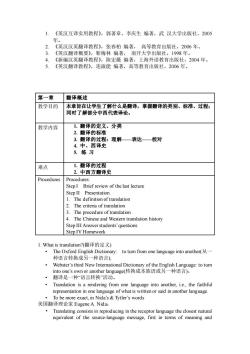
1.《英汉互译实用教程》,郭著章、李庆生编著,武汉大学出版社,2005 2. 《英汉汉英翻译教程》,张春柏编著,高等教育出版社,2006年 3. 《英汉翻译概要》,靳梅林编著,南开大学出版社,1998年。 4. 《新编汉英翻译教程》,陈宏薇编著,上海外语教有出版社,2004年。 5.《英汉翻译教程》,连淑能编著,高等教育出版社,2006年。 第一章 翻译概述 教学目的 本章旨在让学生了解什么是翻译,举握翻译的类别、标准、过程 同时了解部分中西代表译论。 教学内容 1.翻译的定义、分类 2.翻译的标准 3.翻译的过程:理解—表达—校对 难点 1.翻译的过程 2.中西方翻译史 Procedures Procedures: StepI Brief review of the last lecture Step II Presentation 1.The definition of translation The criteria of translation The procedure of translation 4.The Chinese and Western translation history Step III Answer students'questions StepIV Homework L.What is translation?(翻译的定义 The Oxford English Dictionary:to tur from one language into another( 种语言转换成另一种语言上 Webster's third New Intemational Dictionary of the English Language:to tum into one's own or another language((转换成本族语或另一种语言)。 。 翻译是一种“语言转换”活动。 Translation is a rendering from one language into another,i.e.,the faithful representation in one language of what is written or said in another language. To be more exact,in Nida's Tytler's words 美国翻译理论家Eugene A.Nida: Translating consists in reproducing in the receptor language the closest natura equivalent of the source-language message,first in terms of meaning and
1. 《英汉互译实用教程》,郭著章、李庆生 编著,武 汉大学出版社,2005 年。 2. 《英汉汉英翻译教程》,张春柏 编著, 高等教育出版社,2006 年。 3. 《英汉翻译概要》,靳梅林 编著, 南开大学出版社,1998 年。 4. 《新编汉英翻译教程》,陈宏薇 编著,上海外语教育出版社,2004 年。 5. 《英汉翻译教程》,连淑能 编著,高等教育出版社,2006 年。 1. What is translation?(翻译的定义) • The Oxford English Dictionary: to turn from one language into another(从一 种语言转换成另一种语言); • Webster’s third New International Dictionary of the English Language: to turn into one’s own or another language(转换成本族语或另一种语言)。 • 翻译是一种“语言转换”活动。 • Translation is a rendering from one language into another, i.e., the faithful representation in one language of what is written or said in another language. • To be more exact, in Nida’s & Tytler’s words 美国翻译理论家 Eugene A. Nida: • Translating consists in reproducing in the receptor language the closest natural equivalent of the source-language message, first in terms of meaning and 第一章 翻译概述 教学目的 本章旨在让学生了解什么是翻译,掌握翻译的类别、标准、过程; 同时了解部分中西代表译论。 教学内容 1. 翻译的定义、分类 2. 翻译的标准 3. 翻译的过程:理解——表达——校对 4. 中、西译史 5. 练 习 难点 1. 翻译的过程 2. 中西方翻译史 Procedures Procedures: Step I Brief review of the last lecture Step II Presentation 1. The definition of translation 2. The criteria of translation 3. The procedure of translation 4. The Chinese and Western translation history Step III Answer students’ questions Step IV Homework
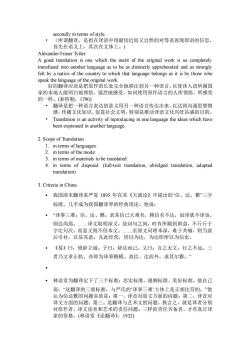
secondly in terms of style (所谓翻译,是指在译语中用最切近而又自然的对等语再现原语的信息 首先在语义上,其次在文体上。) Alexander Fraser Tytler: A good translation is one which the merit of the original work is so completely transfused into another language as to be as distinctly apprehended and as strongly felt by a native of the count to which that language belongs as it is by those wh speak ong 全地移注到另一种语言,以使译入语所属国 家的本地人能明白地领悟、强烈地感受,如同使用原作语言的人所领悟、所感受 的一样。(泰特勒,1790) ·翻译是把一种语言表达的意义用另一种语言传达出来,以达到沟通思想情 感、传播文化知识、促进社会文明,特别是推动译语文化兴旺昌盛的目的。 Translation is an activity of reproducing in one language the ideas which have been expressed in another language 2 Scope of Translation 1 2. 3.in terms of materials to be translated: 4.in terms of disposal:(full-text translation,abridged translation,adapted translation) 3.Criteria in China ·我国清末翻译家严复1895年在其《天演论》中提出的信、达、雅”三字 标准,几乎成为我国翻译界的经典理论。他说: ·“译事三难:信、达、雅。求其信己大难矣,顾信矣不达,虽译犹不译也 则达尚焉。 译文取明深义,故词句之间,时有所颠到附益,不斤斤于 字比句次,而意义则不倍本文。 .至原文词理本深,难于共喻,则当前 后引衬,以显其意。凡此经营,皆以为达,为达即所以为信也。 《易》曰:修辞立诚。子曰:辞达而己。又日:言之无文,行之不远。三 者乃文章正轨,亦即为译事楷模。故信、达而外,求其尔雅。” ·林语堂为翻译定下了三个标准:忠实标准、通顺标准、美好标准。他自己 说:“这朝泽的三重标准,与取氏的泽事三难大体上是正相出符的。”他 认为信达雅的问题实质是:第 译音对原文方面的问题:第 译音对 译文方面的问题:第三。 是翻译与艺术文的问题。换言之,就是译者分别 对原作者、译文读者和艺术的责任问题。三样的责任齐备者、才有真正译 家的资格。(林语堂《论翻译》,1932)
secondly in terms of style. • (所谓翻译,是指在译语中用最切近而又自然的对等语再现原语的信息, 首先在语义上,其次在文体上。) Alexander Fraser Tytler: A good translation is one which the merit of the original work is so completely transfused into another language as to be as distinctly apprehended and as strongly felt by a native of the country to which that language belongs as it is by those who speak the language of the original work. 好的翻译应该是把原作的长处完全地移注到另一种语言,以使译入语所属国 家的本地人能明白地领悟、强烈地感受,如同使用原作语言的人所领悟、所感受 的一样。(泰特勒,1790) • 翻译是把一种语言表达的意义用另一种语言传达出来,以达到沟通思想情 感、传播文化知识、促进社会文明,特别是推动译语文化兴旺昌盛的目的。 • Translation is an activity of reproducing in one language the ideas which have been expressed in another language. 2. Scope of Translation 1. in terms of languages: 2. in terms of the mode: 3. in terms of materials to be translated: 4. in terms of disposal: (full-text translation, abridged translation, adapted translation) 3. Criteria in China • 我国清末翻译家严复 1895 年在其《天演论》中提出的“信、达、雅”三字 标准,几乎成为我国翻译界的经典理论。他说: • “译事三难:信、达、雅。求其信已大难矣,顾信矣不达,虽译犹不译也, 则达尚焉。.译文取明深义,故词句之间,时有所颠到附益,不斤斤于 字比句次,而意义则不倍本文。.至原文词理本深,难于共喻,则当前 后引衬,以显其意。凡此经营,皆以为达,为达即所以为信也。 • 《易》曰:修辞立诚。子曰:辞达而己。又曰:言之无文,行之不远。三 者乃文章正轨,亦即为译事楷模。故信、达而外,求其尔雅。” • • 林语堂为翻译定下了三个标准:忠实标准、通顺标准、美好标准。他自己 说:“这翻译的三重标准,与严氏的‘译事三难’大体上是正相比符的。”他 认为信达雅的问题实质是:第一,译音对原文方面的问题;第二,译音对 译文方面的问题;第三。是翻译与艺术文的问题。换言之,就是译者分别 对原作者、译文读者和艺术的责任问题。三样的责任齐备者、才有真正译 家的资格。(林语堂《论翻译》,1932)
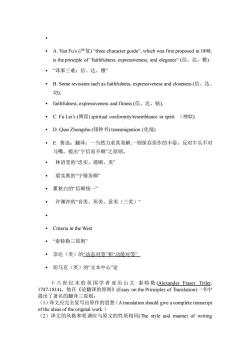
·A.Yan Fu's(严复)"three character guide'”,which was first proposed in 1898, is the principle of“faithfulness,expressiveness,and elegance”(信、达、雅). ·“译事三难:信、达、雅 ·B.Some revisions such as faithfulness,expressiveness and closeness(信、达、 切奶 ·faithfulness,expressiveness and fitness(信、达、贴), ·C.Fu Lei's(傅雷)spiritual conformity/resemblance in spirit(t神似以) ·D.Qian Zhongshu(钱钟书)transmigration(化境) ·E.鲁迅:翻译:一当然力求其易解,一则保存原作的丰姿。反对牛头不对 马嘴,提出“宁信而不顺之原则。 林语堂的“忠实、通顺、美” 梁实秋的“宁错务顺 ·盟秋白的信顺统一” ·许渊冲的“音美、形美、意美(三美)” ·Criteria in the West ·“泰特勒三原则 ·奈达(美)的“动态对等”和“功能对等” ·纽马克(英)的“文本中心”论 十八世纪末的英国学者亚历山大·泰特勒(Alexander Fraser Tytler 1747-1814)。他在《论翻译的原则》(Essay on the Principles of Translation)一书中 提出了著名的翻译 原则 (1)译文应完全复写出原作的思想(Atranslation should give a complete transcript of the ideas of the original work. (2)译文的风格和笔调应与原文的性质相同(The style and manner of writing
• • A. Yan Fu’s (严复) “three character guide”, which was first proposed in 1898, is the principle of “faithfulness, expressiveness, and elegance” (信、达、雅). • “译事三难:信、达、雅” • B. Some revisions such as faithfulness, expressiveness and closeness (信、达、 切); • faithfulness, expressiveness and fitness (信、达、贴), • C. Fu Lei’s (傅雷) spiritual conformity/resemblance in spirit (神似) • D. Qian Zhongshu (钱钟书) transmigration (化境) • E. 鲁迅:翻译:一当然力求其易解,一则保存原作的丰姿。反对牛头不对 马嘴,提出“宁信而不顺”之原则。 • 林语堂的“忠实、通顺、美” • 梁实秋的“宁错务顺” • 瞿秋白的“信顺统一” • 许渊冲的“音美、形美、意美(三美)” • • Criteria in the West • “泰特勒三原则” • 奈达(美)的“动态对等”和“功能对等” • 纽马克(英)的“文本中心”论 十 八 世 纪 末 的 英 国 学 者 亚 历 山 大 ·泰特勒 (Alexander Fraser Tytler, 1747-1814)。他在《论翻译的原则》(Essay on the Principles of Translation)一书中 提出了著名的翻译三原则: (1)译文应完全复写出原作的思想(A translation should give a complete transcript of the ideas of the original work.) (2)译文的风格和笔调应与原文的性质相同(The style and manner of writing
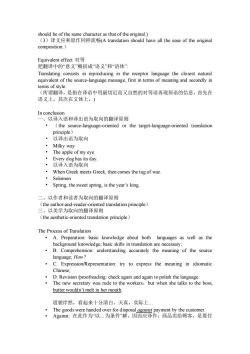
should be of the same character as that of the original (3)译文应和原作同样流畅(A translation should have all the ease of the original composition.) Equivalent effect对等 把翻译中的“意义“概括成“语义和“语体”: Translating consists in r reproducing in the receptor language the natural equivalent of the source-language message,first in terms of meaning and secondly in erms or style (所谓翻译,是指在译语中用最切近而又自然的对等语再现原语的信息,首先在 语义上,其次在文体上。) In conclusio 、以译入语和译出语为取向的翻译原则 the source-language-oriented or the target-language-orented translation principle) ·以译出语为取向 ·Milky way The apple of my eye Every dog has its day. 以译入语为取问 When Greek meets Greek.then comes the tug of war ·Solomon Spring,the sweet spring,is the year's king. 二、以作者和读者为取向的翻译原则 (the author-and-reader-oriented translation principle) 三、以美学为取向的翻译原则 (the aesthetic-oriented translation principle) The Process of Translation A.Preparation:basic knowledge about both languages as well as the background knowledge:basic skills in translation are necessary 。 B.Con prehension understanding accurately the meaning of the source language:How? C.Expression/Representation:try to express the meaning in idiomatic Chinese; d.Revision/proofreading:check again and again to polish the language The new secretary was rude to the workers,but when she talks to the boss butter wouldn't melt in her mouth 道貌岸然,看起来十分清白、天真,实际上 The goods were handed over for disposal against payment by the customer ·Against:在此作为“以.为条件”解。因而应译作:商品卖给顾客,是要付
should be of the same character as that of the original.) (3)译文应和原作同样流畅(A translation should have all the ease of the original composition.) Equivalent effect 对等 把翻译中的“意义”概括成“语义”和“语体”: Translating consists in reproducing in the receptor language the closest natural equivalent of the source-language message, first in terms of meaning and secondly in terms of style. (所谓翻译,是指在译语中用最切近而又自然的对等语再现原语的信息,首先在 语义上,其次在文体上。) In conclusion 一、以译入语和译出语为取向的翻译原则 • (the source-language-oriented or the target-language-oriented translation principle) • 以译出语为取向 • Milky way • The apple of my eye • Every dog has its day. • 以译入语为取向 • When Greek meets Greek, then comes the tug of war. • Solomon • Spring, the sweet spring, is the year’s king. 二、以作者和读者为取向的翻译原则 (the author-and-reader-oriented translation principle) 三、以美学为取向的翻译原则 (the aesthetic-oriented translation principle) The Process of Translation • A. Preparation: basic knowledge about both languages as well as the background knowledge; basic skills in translation are necessary; • B. Comprehension: understanding accurately the meaning of the source language; How? • C. Expression/Representation: try to express the meaning in idiomatic Chinese; • D. Revision /proofreading: check again and again to polish the language. • The new secretary was rude to the workers,but when she talks to the boss, butter wouldn’t melt in her mouth. 道貌岸然,看起来十分清白、天真,实际上. • The goods were handed over for disposal against payment by the customer. • Against: 在此作为“以.为条件”解。因而应译作:商品卖给顾客,是要付
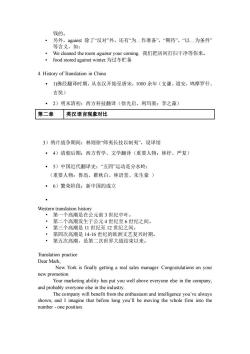
钱的。 另外 against除了反对外,还有为.作准备,期待,“以为条件 等含义,如 We cleaned the room against your coming.我们把房间打扫干净等你来。 ·food stored against winter.为过冬贮备 4.History of Translation in China ·1)佛经翻译时期,从东汉开始至唐宋,1000余年(支谦、道安,鸠摩罗什、 玄奘) ·2)明末清初:西方科技翻译(徐光启、利玛窦:李之藻) 第二章英汉语言现象对比 3)鸦片战争期间:林则徐“师夷长技以制夷”,设译馆 ·4)清朝后期:西方哲学、文学翻译(重要人物:林纾、严复) ·5)中国近代翻译史:“五四”运动是分水岭: (重要人物:鲁迅、瞿秋白、林语堂、朱生豪) ·6)繁荣阶段:新中国的成立 ~高潮是在公元前3世纪中叶。 第二个高潮发生于公元4世纪至6世纪之间。 ·第三个高潮是11世纪至12世纪之间。 ·第四次高潮是14-16世纪的欧洲文艺复兴时期。 ·第五次高海,是第二次世界大战结束以来。 Translation practice Dear Mark, New York is finally getting a real sales manager.Congratulations on your new promotion. Your marketing ability has put you well above everyone else in the company, and probably everyone else in the industry. The company will benefit from the enthusiasm and intelligence you've always shown,and I imagine that before long you'll be moving the whole firm into the number-one position
钱的。 • 另外,against 除了“反对”外,还有“为.作准备”,“期待”,“以.为条件” 等含义,如: • We cleaned the room against your coming. 我们把房间打扫干净等你来。 • food stored against winter.为过冬贮备 4. History of Translation in China • 1)佛经翻译时期,从东汉开始至唐宋,1000 余年(支谦、道安,鸠摩罗什、 玄奘) • 2)明末清初:西方科技翻译(徐光启、利玛窦;李之藻) 3)鸦片战争期间:林则徐“师夷长技以制夷”,设译馆 • 4)清朝后期:西方哲学、文学翻译(重要人物:林纾、严复) • 5)中国近代翻译史:“五四”运动是分水岭; (重要人物:鲁迅、瞿秋白、林语堂、朱生豪 ) • 6)繁荣阶段:新中国的成立 • Western translation history • 第一个高潮是在公元前 3 世纪中叶。 • 第二个高潮发生于公元 4 世纪至 6 世纪之间。 • 第三个高潮是 11 世纪至 12 世纪之间。 • 第四次高潮是 14-16 世纪的欧洲文艺复兴时期。 • 第五次高潮,是第二次世界大战结束以来。 Translation practice Dear Mark, New York is finally getting a real sales manager. Congratulations on your new promotion. Your marketing ability has put you well above everyone else in the company, and probably everyone else in the industry. The company will benefit from the enthusiasm and intelligence you’ve always shown, and I imagine that before long you’ll be moving the whole firm into the number - one position. 第二章 英汉语言现象对比

教学目的 to learn about the similarities and differences of Chinese and English in w ord forming and vocabulary so as to translat them accurately 教学内容 1.Comparative studies of language family 2.Cor arative studies of word building in English and Chines 3. Comparative studies of syllable Exercise 难点 The differences between the Chinese and English language Procedures Procedures Step I Brief review of the last lecture StepII Presentation 1.The language features of the Chinese language 2.The language features of English 3.The differences between the Chinese language and English Step IlI Answer students'questions Step IV Homework L.Language Families(语系) branch of the Indo-European It is well known that English has the richest vocabulary of any European language. On the basis of Angles'language (Anglo-Saxon),English was built by absorbing words in various languages: E. Latin:Pen,pencil,cup,butter,silk French:pork.feast.sir.noble. Italian:piano,solo,studio,opera,umbrella,pilgrim, Chinese:tea,c ow mein,kowtow,toufu, Originally English had its gender,case,number,conjugation-these complicated changes.Because of the wide borrowings,English couldn't keep the changes,case disappearing,gender being not so strict as some other languages,only remaining and only nouns having the changes words can only be formed by means of derivation,composition and conversion,etc. II.Word-building The major ways of word-building in English are composition.conversion. Composition:motherland,blackboard,waterworks,handwriting.silkworm,outbreak
I. Language Families (语系) English belongs to the Germanic branch of the Indo-European language family(印欧语系). Chinese belongs to the Sino-Tibetan language family(汉藏语系). It is well known that English has the richest vocabulary of any European language. On the basis of Angles’ language (Anglo-Saxon), English was built by absorbing words in various languages: E.g. Latin: Pen, pencil, cup, butter, silk French: pork, feast, sir, noble, Italian: piano, solo, studio, opera, umbrella, pilgrim, Spanish: cargo, cigarette, cigar, Greek: paper, alphabet, dialogue, comedy Chinese: tea, chow mein, kowtow, toufu, Originally English had its gender, case, number, conjugation—these complicated changes. Because of the wide borrowings, English couldn’t keep the changes, case disappearing, gender being not so strict as some other languages, only subjective case and objective case remaining and only pronouns having the changes. As English absorbed foreign words only, without absorbing grammar rules, new words can only be formed by means of derivation, composition and conversion, etc. II. Word-building The major ways of word-building in English are composition, conversion, and derivation (affixation). And in Chinese we have the same major ways. English: Composition: motherland, blackboard, waterworks, handwriting, silkworm, outbreak, 教学目的 to learn about the similarities and differences of Chinese and English in word forming and vocabulary so as to translate them accurately. 教学内容 1. Comparative studies of language family 2. Comparative studies of word building in English and Chinese 3. Comparative studies of syllable Exercise 难点 The differences between the Chinese and English language Procedures Procedures: Step I Brief review of the last lecture Step II Presentation 1. The language features of the Chinese language 2. The language features of English 3. The differences between the Chinese language and English Step III Answer students’ questions Step IV Homework
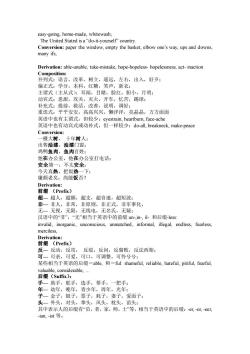
ar a ountry Conversion:paper the window,empty the basket,elbow one's way,ups and downs. many ifs. Derivation:able-unable.take-mistake,hope-hopeless-hopelessness,act-inaction 并列式语言,改革,树立,遥远,左右,出入,好万: 偏正式:学分,本科,红糖,笑声,新衣: 主谓式(主从式):耳闻,目睹,脸红,胆小,月明: 动宾式:思甜,攻关,灭火,开车,忆苦,踢球; 补充式:提前,救话,改善,说明,调好: 重迭式:平平安安,高高兴兴,懒洋洋,亮晶晶,方方面面 英语中也有主谓式, 但较少:eyestrain,.heartbum,face-ache 英语中也有动宾式或动补式,但一样较少:do-al,breakneck,make-peace Conversion: 一棵大树,十年树人: 出售油漆,油漆门窗: 鸡鸭鱼肉,鱼肉百姓 他在办公室,他在办公室打电话: 安全第一,不太安全: 今天真热,把饭热一下: 廉颇老矣,尚能饭否? 超一超人,超额,超支,超音速,超短波: 非一非人,非常,非原则,非正式,非军事化, 无一无视,无限,无线电,无名氏,无疑: 汉语中的非”,“无”相当于英语中的前缀un-,in,正.和后缀-less invalid,inorganic,unconscious,unmatched,informal,illegal,endless,fearless, merciless, Derivation: 前缀(Prefix) 反一反动,反攻,反驳,反问,反腐败,反法西斯 可一可亲, 可 可口, 可调整,可怜兮兮 某些相当于英语的后缀-able,和一ful:shameful,reliable,.hateful,pitiful,fearful, valuable.considerable. 缀(Sui): 手 助手,舵手,选手,帮手,一把手: 幼年,晚年,青少年,周年,光年 子 金子,银子,票子,耗子,子,爱面子: 头一外头,对头,拳头,风头,枕头,苗头: 其中表示人的后缀有“员,者,家,师,士等,相当于英语中的后缀:eror,eer, ian.-ist等
easy-going, home-made, whitewash; The United Stated is a “do-it-yourself” country. Conversion: paper the window, empty the basket, elbow one’s way, ups and downs, many ifs; Derivation: able-unable, take-mistake, hope-hopeless- hopelessness, act- inaction Composition: 并列式:语言,改革,树立,遥远,左右,出入,好歹; 偏正式:学分,本科,红糖,笑声,新衣; 主谓式(主从式):耳闻,目睹,脸红,胆小,月明; 动宾式:思甜,攻关,灭火,开车,忆苦,踢球; 补充式:提前,救活,改善,说明,调好; 重迭式:平平安安,高高兴兴,懒洋洋,亮晶晶,方方面面 英语中也有主谓式,但较少:eyestrain, heartburn, face-ache 英语中也有动宾式或动补式,但一样较少:do-all, breakneck, make-peace Conversion: 一棵大树, 十年树人; 出售油漆,油漆门窗; 鸡鸭鱼肉,鱼肉百姓; 他在办公室,他在办公室打电话; 安全第一,不太安全; 今天真热,把饭热一下; 廉颇老矣,尚能饭否? Derivation: 前缀 (Prefix) 超— 超人,超额,超支,超音速,超短波; 非— 非人,非常,非原则,非正式,非军事化, 无— 无视,无限,无线电,无名氏,无疑; 汉语中的“非”,“无”相当于英语中的前缀 un-,in-, il- 和后缀-less: invalid, inorganic, unconscious, unmatched, informal, illegal, endless, fearless, merciless, Derivation: 前缀 (Prefix) 反— 反动,反攻, 反驳,反问,反腐败,反法西斯; 可— 可亲,可爱,可口,可调整,可怜兮兮; 某些相当于英语的后缀-able, 和-ful: shameful, reliable, hateful, pitiful, fearful, valuable, considerable, . 后缀(Suffix): 手— 助手,舵手,选手,帮手,一把手; 年— 幼年,晚年,青少年,周年,光年; 子— 金子,银子,票子,耗子,妻子,爱面子; 头— 外头,对头,拳头,风头,枕头,苗头; 其中表示人的后缀有“员,者,家,师,士”等,相当于英语中的后缀:-er, -or, -eer, -ian, -ist 等
按次数下载不扣除下载券;
注册用户24小时内重复下载只扣除一次;
顺序:VIP每日次数-->可用次数-->下载券;
- 《翻译理论与实践》课程教学资源(教案讲义)汉英翻译教案(内蒙古科技大学:赵蕾).doc
- 《翻译理论与实践》课程教学资源(教案讲义)口译教案.doc
- 《翻译理论与实践》课程教学大纲(英语笔译 English-Chinese Translation、英语口译 A Practical Course in Interpretation).pdf
- 《俄语入门》课程教学课件(PPT讲稿)第6课 Урок 6.ppt
- 《俄语入门》课程教学课件(PPT讲稿)第5课 Урок 5.ppt
- 《俄语入门》课程教学课件(PPT讲稿)第4课 Урок 4.ppt
- 《俄语入门》课程教学课件(PPT讲稿)第3课 Урок 3.ppt
- 《俄语入门》课程教学课件(PPT讲稿)第2课 Урок 2.ppt
- 《俄语入门》课程教学课件(PPT讲稿)第1课 Урок 1.ppt
- 山东理工大学:《财务管理专业英语》课程教学课件(PPT讲稿)Topic 6 风险与收益(中文).ppt
- 山东理工大学:《财务管理专业英语》课程教学课件(PPT讲稿)Topic 5 货币时间价值与估价(中文).ppt
- 山东理工大学:《财务管理专业英语》课程教学课件(PPT讲稿)Topic 6 Risk and return.ppt
- 山东理工大学:《财务管理专业英语》课程教学课件(PPT讲稿)Topic 5 Time value of money and valuation.ppt
- 《大学英语读写》课程教学资源(B)Ⅱ_大学英语读写(B)Ⅱ_B2U1.pdf
- 《大学英语读写》课程教学资源(B)Ⅱ_大学英语读写2册 Unit 1 text_Unit1 AR1.ppt
- 《大学英语读写》课程教学资源(B)Ⅱ_大学英语读写(B)Ⅱ_导论.ppt
- 《大学英语读写》课程教学资源(B)Ⅱ_大学英语读写(B)Ⅱ_Ken's book.pdf
- 《大学英语读写》课程教学资源(B)Ⅱ_大学英语读写(B)Ⅱ_academic writing.pdf
- 《大学英语读写》课程教学资源(B)Ⅱ_大学英语读写(B)Ⅱ_academic speaking.pdf
- 《大学英语读写》课程教学资源(B)Ⅱ_大学英语读写(B)Ⅱ_academic listening.pdf
- 《翻译理论与实践》课程PPT教学课件(汉英)汉英翻译 CHINESE-ENGLISH TRANSLATION.ppt
- 《翻译理论与实践》课程PPT教学课件(英汉)英汉翻译 A COURSE OF ENGLISH-CHINESE TRANSLATION.ppt
- 《中学英语教学法》课程教学大纲.pdf
- 《中学英语教学法》课程标准:基础教育课程改革纲要.doc
- 《中学英语教学法》课程标准:国家中长期教育改革和发展规划纲要.doc
- 《中学英语教学法》课程标准:义务教育初中英语课程标准.doc
- 《中学英语教学法》课程标准:高中英语新课程.doc
- 《中学英语教学法》课程教学资源:英语教学中的简笔画.doc
- 《中学英语教学法》课程PPT讲稿(课堂教学策略)学业成绩不良的诊断与预防.ppt
- 《中学英语教学法》课程PPT讲稿(课堂教学策略)课堂教学设计-提升课堂教学有效性的基本路径.ppt
- 《中学英语教学法》课程PPT讲稿(课堂教学策略)对中小学外语教学中科研的几点看法.ppt
- 《中学英语教学法》课程PPT讲稿(课堂教学策略)初中英语教学评价.ppt
- 《中学英语教学法》课程PPT讲稿(课堂教学策略)初中英语有效教学策略探讨.ppt
- 《中学英语教学法》课程PPT讲稿(课堂教学策略)英语老师行动研究 English Teachers inAction Research.ppt
- 《中学英语教学法》课程PPT讲稿(课堂教学策略)树立正确的外语学习观是提高外语教学效率的关键.ppt
- 《中学英语教学法》课程PPT讲稿(课堂教学策略)如何开展培训需求分析.ppt
- 《中学英语教学法》课程PPT讲稿(课堂教学策略)英语教师语言敏感意识提升与课堂教学——基于观课的反思.ppt
- 《中学英语教学法》课程PPT讲稿(课堂教学策略)高中英语课堂观察与评价.ppt
- 《中学英语教学法》课程PPT讲稿(学科教学论)Chapter nine Language Teachers in Classroom Teaching.ppt
- 《中学英语教学法》课程PPT讲稿(学科教学论)Chapter eight Theories of Test(1/2).ppt
